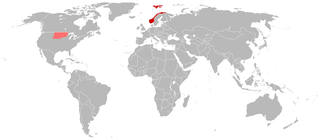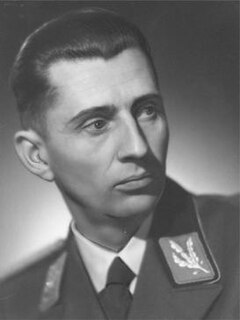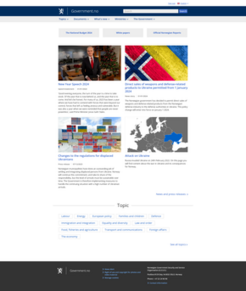The Ministry of Culture and Enlightenment (Norwegian : Kultur- og folkeopplysningsdepartementet) was a government ministry during the German occupation of Norway, established on 25 September 1940, and closed down at the end of World War II.

Norwegian is a North Germanic language spoken mainly in Norway, where it is the official language. Along with Swedish and Danish, Norwegian forms a dialect continuum of more or less mutually intelligible local and regional varieties, and some Norwegian and Swedish dialects, in particular, are very close. These Scandinavian languages, together with Faroese and Icelandic as well as some extinct languages, constitute the North Germanic languages. Faroese and Icelandic are hardly mutually intelligible with Norwegian in their spoken form because continental Scandinavian has diverged from them. While the two Germanic languages with the greatest numbers of speakers, English and German, have close similarities with Norwegian, neither is mutually intelligible with it. Norwegian is a descendant of Old Norse, the common language of the Germanic peoples living in Scandinavia during the Viking Era.
A ministry is a governmental organisation, headed by a minister, that is meant to manage a specific sector of public administration. Governments may have differing numbers and types of ministries, but the Brockhaus and Efron Encyclopedic Dictionary notes that all states have a Ministry of Interior, a Ministry of Foreign Affairs, a Ministry of Defense, a Ministry of Justice and a Ministry of Finance. A Ministry of Education or similar is also commonly present.

The German occupation of Norway during World War II began on 9 April 1940 after German forces invaded the neutral Scandinavian country of Norway. Conventional armed resistance to the German invasion ended on 10 June 1940 and the Germans controlled Norway until the capitulation of German forces in Europe on 8/9 May 1945. Throughout this period, Norway was continuously occupied by the Wehrmacht. Civil rule was effectively assumed by the Reichskommissariat Norwegen, which acted in collaboration with a pro-German puppet government, the Quisling regime, while the Norwegian King Haakon VII and the prewar government escaped to London, where they acted as a government in exile. This period of military occupation is in Norway referred to as the "war years" or "occupation period".
The ministry was set up on 25 September 1940 by Reichskommissar Josef Terboven as a consequence of the occupation of Norway by Nazi Germany during World War II. It consisted of three departments and four directorates. The ministry was initially headed by Gulbrand Lunde until 30 November 1942, and thereafter by Rolf Jørgen Fuglesang
Reichskommissar, in German history, was an official gubernatorial title used for various public offices during the period of the German Empire and the Third Reich.

Josef Antonius Heinrich Terboven was a Nazi leader, best known as the Reichskommissar for Norway during the German occupation of Norway and the Quisling regime.
Departmentalization refers to the process of grouping activities into departments. Division of labour creates specialists who need coordination. This coordination is facilitated by grouping specialists together in departments.
One of the departments, the Propaganda Department, was renamed Department for Popular Enlightenment in 1944.
The best known directorate was the Norwegian Press Directorate. The Norwegian Broadcasting Corporation (NRK), the National Gallery of Norway, the Norwegian National Academy of Fine Arts and all other non-scientific museums were subordinate to the Pressedirektoratet.
The Norwegian Press Directorate was a Norwegian government agency within the Ministry of Culture and Enlightenment between 1940 and 1945. Anders Beggerud was the director during the entire Second World War.

The Norwegian National Academy of Arts is a Norwegian Academy offering studies in the area of Fine Art. The Academy currently offers 3-year bachelor and 2-year MA programmes. The "Norwegian National Academy of the Arts" is still referred to simply as Kunstakademiet or the Art Academy amongst both Staff and students.
The department was modelled after the Reichskommissariats Hauptabteilung Volksaufklaerung und Propaganda ("Ministry for Popular Enlightenment and Propaganda"), trying to spread Nazi ideology in Norway.
National Socialism, more commonly known as Nazism, is the ideology and practices associated with the Nazi Party – officially the National Socialist German Workers' Party – in Nazi Germany, and of other far-right groups with similar aims.

Norway, officially the Kingdom of Norway, is a Nordic country in Northern Europe whose territory comprises the western and northernmost portion of the Scandinavian Peninsula; the remote island of Jan Mayen and the archipelago of Svalbard are also part of the Kingdom of Norway. The Antarctic Peter I Island and the sub-Antarctic Bouvet Island are dependent territories and thus not considered part of the kingdom. Norway also lays claim to a section of Antarctica known as Queen Maud Land.
Documents from this department are archived by the National Archival Services of Norway.

The National Archival Services of Norway is a Norwegian government agency that is responsible for keeping state archives, conducts control of public archiving and works to preserve private archives. It is subordinate to the Ministry of Culture and Church Affairs and consists of the National Archive, eight regional state archives and The Sámi Archives. The organization has 190 employees and about 120 kilometers (75 mi) of materials. The oldest complete document is from 1189. It is a letter issued on 28 January 1189 by Pope Clement III (1187-1191) to all clergymen in Norway.











